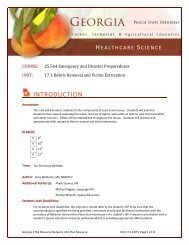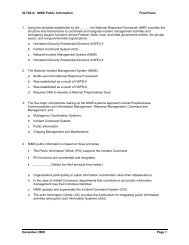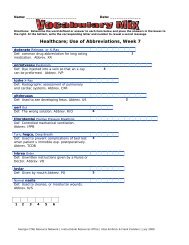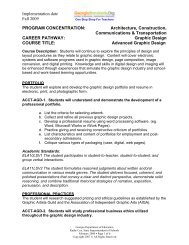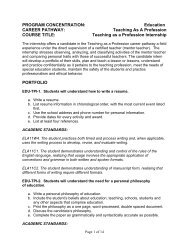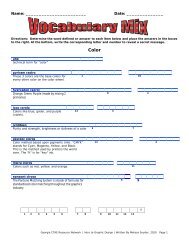emt-basic curriculum module 4
emt-basic curriculum module 4
emt-basic curriculum module 4
Create successful ePaper yourself
Turn your PDF publications into a flip-book with our unique Google optimized e-Paper software.
HBF-TWN Trade & Gender Briefs5Table 1: The Shift from WTO to FTAs by Provisions/ Chapters and Associated Gender ImplicationsArea/ Provision WTO FTAs Gender ImplicationsPrincipleDevelopmentConcessionReciprocityOften adverse as SP concessions are not allowedCommodity Trade:TariffsFrom BoundRates, losesflexibilityActual Applied Rates,loses full protectionDeveloping countries lose more under both. FTAs create realcompetition for all groups, small producers may lose as they are notbacked by big capitalNTBs: Standards,TBTsAgreementAffirmation of WTOlevels or often moreWomen producers may find it more difficult to meet higherstandards and technical process requirementsNAMA: Anticoncentrationclause and sectoralsYes (beingnegotiated)May be includedUnder the anti-concentration clause, entire sectors cannot beprotected, a problem where women dominate. Under ‘sectorals’stiff competition opens up in sectors covered with immediate effectLabour standards Not Included May be included inFTAs with developedcountriesMay be good for women workers but inclusion in trade agreementsis controversialInvestmentOnly traderelatedinvestment isdiscussedYes, throughinvestment chaptersMay allow significant market access and protection for foreigninvestors which may increase competition for womenentrepreneurs. Women may get more jobs in foreign enterprises butFDI is also often labour saving and targets women’s labourIntellectualProperty RightsYes, but TRIPSunder WTO offersmany flexibilitiesTRIPS plus provisionsare coming in throughFTAsWomen can lose as they are weaker in terms of access toknowledge and technology and at registering IP instruments suchas patents, copyrights, trademarks, etc.Publicprocurement,competition policyNot included onmandatory basisMay be included inFTAs with developedcountriesCan take away certain benefits for women producers in publicprocurement and certain state subsidiesReferencesGhosh, Jayati (2006) “Note on Gender and Macroeconomics”, Paper submitted and presented at session on 'Integration of GenderPerspectives in Macroeconomics', Commission on the Status of Women, Forty-ninth session, United Nations, 28 February-11March, New York.Hirway, Indira and Seeta Prabhu (2009) Global Economic Crisis: Impact on the Poor in India – A Synthesis of Sector Studies,UNDP.Jhabvala, Renana (2003) Globalization, Liberalization and Women in the Informal Economy” in Veena Jha (ed.) Trade,Globalisation, and Gender: Evidence from South Asia, UNIFEM in collaboration with UNCTAD, New DelhiNational Commission for Enterprises in the Unorganised Sector (2007): Report on Conditions of Work and Promotion ofLivelihoods in the Unorganised Sector, Government of India, August, New Delhi.Sengupta, Ranja and Abhilash Gopinath (2009) The Current Trade Framework and Gender Linkages in Developing Economies:An Introductory Survey of Issues with Special Reference to India’, Trade and Gender Series, Paper I, Centad and Heinrich BollFoundation, DecemberTran-Nguyen, A-N and A Beviglia Zampetti (2004) Trade and Gender: Opportunities and Challenges for Developing Countries,UNCTAD, GenevaVan Staveren, Irene, Diane Elson, Caren Grown and Nilufer Cagatay (eds.) (2007) The Feminist Economics of Trade, Colchest:Francis Taylor Group, 2007. ISBN 978 0 415 43637 38This Brief is the fifth of the ‘Trade and Gender Briefs’ Series published by the Third World Network (TWN) andHeinrich Boell Foundation (HBF) India. The series is published for information dissemination on issues related to thegender specific impacts of trade liberalisation in India and other developing economies.Author: Ranja Sengupta Date of Publication: August 2012 Printed by: InditeGlobal, New DelhiFor More Information: Contact Ranja Sengupta at ranja.sengupta@gmail.comDisclaimer: The views analysis and conclusions are of the authors only and may not necessarily reflect the views or position ofTWN & HBF. Readers are encouraged to quote or cite this Brief with due acknowledgement to the authors, TWN & HBF.Copyright: This work is licensed under a Creative Commons Attribution-NonCommercial-NoDerivs 3.0 License.Acknowledgement: Shalini Yog, Santhosh M.R., and to Centad for including this brief in its “Trade and Gender AdvocacyProjects, August 2012.



